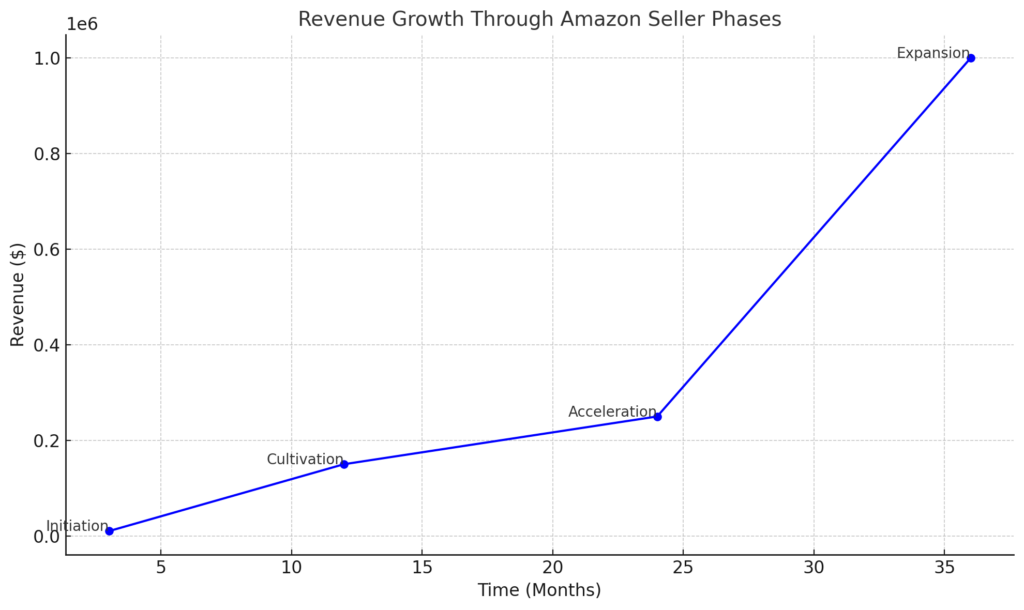The Evolution of an Amazon Seller Account
Building a successful Amazon store requires time, strategy, and a deep understanding of Amazon’s hidden trust-building processes. Though Amazon doesn’t officially publish exact metrics, many sellers agree that the journey to success follows a series of stages, each marked by increasing trust, expanded sales opportunities, and greater exposure to customers. Here, we outline these stages, along with insights and real-world milestones.
1. Initiation Phase: Establishing Basic Trust
At the start of the journey, the Amazon Seller Account is in its Initiation phase. This is akin to a probationary period, where trust with Amazon is minimal. During this phase:
- The seller is restricted in terms of the number of items they can list and sell.
- Amazon deliberately limits exposure to reduce their risk, allowing only a small volume of transactions to go through.
- The account is closely monitored, and its success depends on adhering to Amazon’s strict performance metrics.
Typically, this phase lasts between 1 to 3 months. Sellers should focus on accuracy, compliance, and providing excellent customer service to progress to the next phase.
Your goal during this phase is to gain Amazon’s initial trust by meeting key performance metrics like Order Defect Rate (ODR) and Customer Feedback Scores(Seller Labs)(FBA Prep – PIPISI).
2. Cultivation Phase: Earning Broader Trust
After the initiation phase, the seller moves into the Cultivation phase, lasting roughly 6 to 12 months. This is a period of nurturing the account’s growth, as the seller works to gain Amazon’s trust through positive actions:
- Growing transaction volume.
- Building revenue steadily.
- Harvesting positive reviews and ensuring customer satisfaction.
This stage involves continuously maturing the account, much like cultivating a garden. As the account grows in these key areas, Amazon begins to loosen restrictions and increases exposure to its customer base.
During this stage, maintaining strong performance in areas like Inventory Performance Index (IPI) and customer reviews is crucial for building trust. (FBA Prep – PIPISI)(SimpliWorks).
3. Acceleration Phase: Building Momentum
By month 12, and after crossing a threshold of approximately $250,000 in revenue, the store enters the Accelerationphase. This is where growth takes off:
- Amazon begins to trust the seller, removing many of the restrictions that were present in the earlier phases.
- The seller is granted more visibility, and their products are exposed to a wider customer base.
- Increased velocity becomes possible as sales grow significantly.
This phase is crucial for building momentum. The trust built with Amazon leads to more organic traffic and the potential for rapid growth, provided inventory and pricing strategies are optimized. (Seller Labs)(Danalyser).
4. Expansion Phase: Scaling and Optimizing
After about two years and surpassing $1 million in revenue, the store reaches the Expansion phase. Here, the seller has established a strong reputation, and Amazon no longer inhibits growth:
- The store’s success is now driven primarily by product selection, pricing, and inventory velocity.
- Sellers can truly scale their operations, focusing on optimizing their business to maximize profit and efficiency.
- Amazon may even begin assisting the store in some ways, such as offering improved logistics support or access to premium services.
This stage is marked by long-term sustainability and growth. With three or more years on the platform and revenue surpassing $5 million, sellers can enjoy greater benefits from Amazon, such as invitations to exclusive programs. (FBA Prep – PIPISI)(Danalyser).
Final Thoughts:
The journey through these stages reflects Amazon’s growing trust in your business. From Initiation to Expansion, understanding Amazon’s key performance metrics and scaling strategies is essential. By focusing on data-driven decisions, advertising performance, and customer satisfaction, sellers can navigate the platform’s hidden barriers and unlock long-term success.
Visual Insights:
I’ve prepared some data-driven charts to show the progression through each phase, from revenue growth to the importance of various metrics like customer feedback, advertising ROI, and performance metrics.
Here’s a chart that visualizes the revenue growth across the four phases of an Amazon seller’s journey. Each point marks a significant milestone, showing the progression from the Initiation phase through to Expansion. The time it takes to reach these milestones can vary, but this chart provides a general guideline for the typical revenue growth trajectory.
